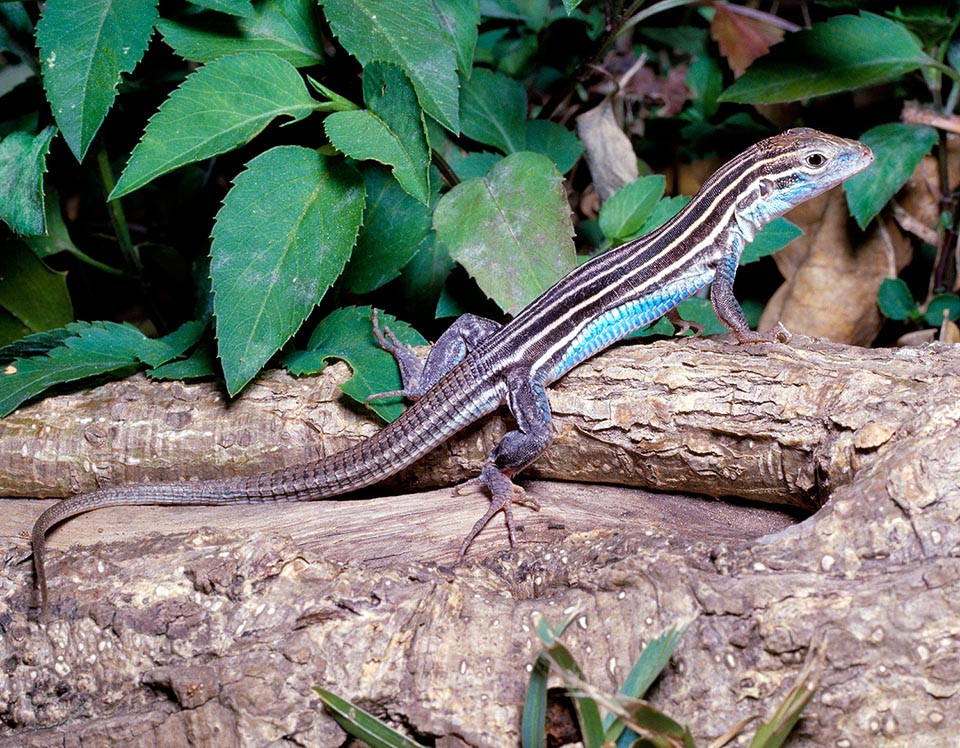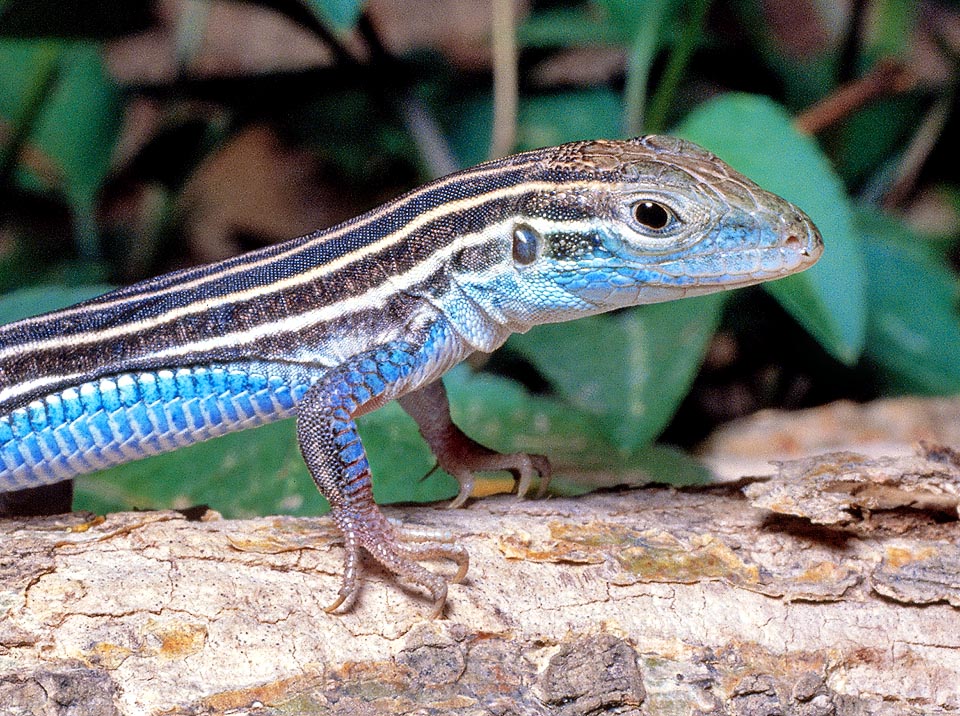Family : Teiidae

Text © Giuseppe Mazza

English translation by Mario Beltramini
The Six-lined racerunner (Aspidoscelis sexlineata Linnaeus, 1766), known also as Cnemidophorus sexlineatus, is a diurnal lizard belonging to the family of the Teiidae defined “with armoured legs” in the old genus Cnemidophorus from the Greek “κνημιδοφόρος” (cnemidophoros) = that wears the shin guards, the part of the armour that protects the fore part of the legs, as well as in the new genus Aspidoscelis, always from the Greek “ἀσπίς, -ίδος” (aspis, -idos) = shield + “σκέλος ” (skelos) = leg. As a matter of fact, the legs of this reptilian appear protected, as also the abdomen, by big horizontal blue plates.
The Latin name of the species, sexlineata, refers to the six longitudinal lines that starting from the head cross the body of the animal to fade only partially towards the tail.
Zoogeography
It is present in the central and eastern part of the south of USA and in the states of Sonora and Tamaulipas in Mexico. On the eastern coast, proceeding northwards, we find it from Florida to Maryland where due to the low temperatures it reproduces later after a long period of winter quiescence.

The Aspidoscelis sexlineata is a very fast lizard of the south of USA and of Mexico, able to run at thirty kilometres per hour © Giuseppe Mazza
Ecology-Habitat
Seen its vast distribution, we find it in various habitats, from the plain up to about 400 m of altitude. Frequent in arid and sandy zones, but also in the prairies with low grass and sparse woods where in case of danger may run away very fast, dashing, even at thirty kilometres per hour.
Morphophysiology
It reaches the 30 cm, including the thin tail, often long twice than the body. The head is small, the trunk slender, protected above by granular scales. It is a species is to recognize thanks to the six clear longitudinal lines of the back, that continue partially on the tail, on a dark green, brown or black background. Yellowish in the young and in the females they may get light blue hues in the males, especially during the reproductive period. The lower part of the body is white in the females and pale blue in the males with 8 rows of big rectangular scales on the abdomen.
Ethology-Reproductive Biology
The Aspidoscelis sexlineata nourishes of insects, often harmful for agriculture, besides spiders, worms and snails.

The adult males display splendid light blue plates, on the belly and on the fore limbs, like shin guards, that part of the old armours that protected the shins, as recalled by the scientific names. It lives in arid and sandy zones, but also in prairies of low grasses and sparse woods allowing good visibility and offering ample possibilities for escape © Giuseppe Mazza
Active only during the nice weather days, it gets out hunting in the morning and takes shelter from the heat in the afternoon in makeshift homes or dens dug artfully with the fore limbs. They usually have two openings and one is closed from inside when the animal is at home.
They also serve for sheltering from the cold of the night, and for the period of winter quiescence and host at times the 4-6 eggs the female lays even twice a year during the summer. However, these are usually placed under the trunks of trees fallen to the ground or in thin and unusual lateral tunnels artfully dug inside the tunnels of the moles.
Upon birth, after 6-8 weeks of incubation, the newborns measure 3 cm, tail excluded. The young have often blue tail but later, while growing, the colour fades. The snakes are their main predators when they surprise them in their dens, because in the open soil it is rare that the adults let them to be caught. When captive, the Aspidoscelis sexlineata can live even 6 years and is not an endangered species.
Synonyms
Lacerta sexlineata Linnaeus, 1766; Cnemidophorus sexlineatus (Linnaeus, 1766); Cnemidophorus sexlineatus viridis Lowe, 1966; Cnemidophorus sexlineatus stephensae Trauth, 1992.
→ To appreciate the biodiversity within the LIZARDS please click here.
